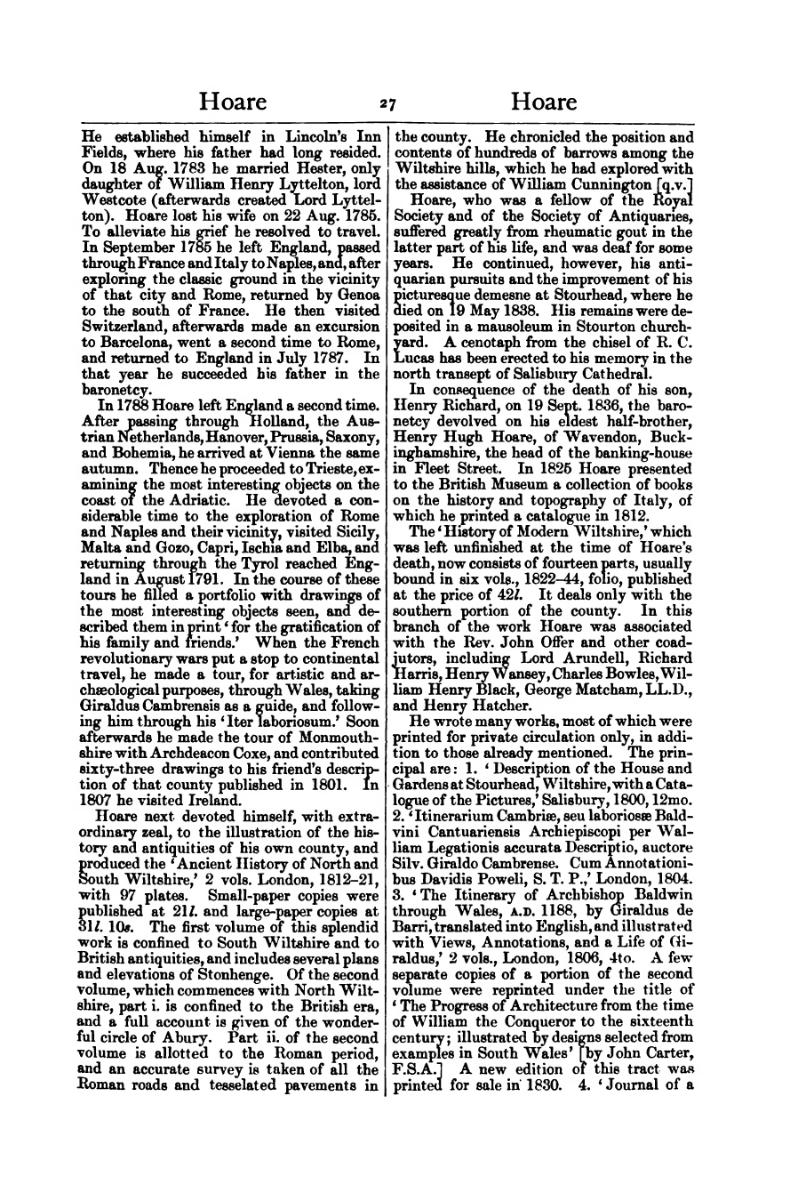He established himself in Lincoln's Inn Fields, where his father had long resided. On 18 Aug. 1783 he married Hester, only daughter of William Henry Lyttelton, lord Westcote (afterwards created Lord Lyttelton). Hoare lost his wife on 22 Aug. 1785. To alleviate his grief he resolved to travel. In September 1785 he left England, passed through France and Italy to Naples, and, after exploring the classic ground in the vicinity of that city and Rome, returned by Genoa to the south of France. He then visited Switzerland, afterwards made an excursion to Barcelona, went a second time to Rome, and returned to England in July 1787. In that year he succeeded his father in the baronetcy.
In 1788 Hoare left England a second time. After passing through Holland, the Austrian Netherlands, Hanover, Prussia, Saxony, and Bohemia, he arrived at Vienna the same autumn. Thence he proceeded to Trieste, examining the most interesting objects on the coast of the Adriatic. He devoted a considerable time to the exploration of Rome and Naples and their vicinity, visited Sicily, Malta and Gozo, Capri, Ischia and Elba, and returning through the Tyrol reached England in August 1791. In the course of these tours he filled a portfolio with drawings of the most interesting objects seen, and described them in print ‘for the gratification of his family and friends.’ When the French revolutionary wars put a stop to continental travel, he made a tour, for artistic and archæological purposes, through Wales, taking Giraldus Cambrensis as a guide, and following him through his ‘Iter laboriosum.’ Soon afterwards he made the tour of Monmouthshire with Archdeacon Coxe, and contributed sixty-three drawings to his friend's description of that county published in 1801. In 1807 he visited Ireland.
Hoare next devoted himself, with extraordinary zeal, to the illustration of the history and antiquities of his own county, and produced the ‘Ancient History of North and South Wiltshire,’ 2 vols. London, 1812–21, with 97 plates. Small-paper copies were published at 21l. and large paper copies at 31l. 10s. The first volume of this splendid work is confined to South Wiltshire and to British antiquities, and includes several plans and elevations of Stonhenge. Of the second volume, which commences with North Wiltshire, part i. is confined to the British era, and a full account is given of the wonderful circle of Abury. Part ii. of the second volume is allotted to the Roman period, and an accurate survey is taken of all the Roman roads and tesselated pavements in the county. He chronicled the position and contents of hundreds of barrows among the Wiltshire hills, which he had explored with the assistance of William Cunnington [q. v.]
Hoare, who was a fellow of the Royal Society and of the Society of Antiquaries, suffered greatly from rheumatic gout in the latter part of his life, and was deaf for some years. He continued, however, his antiquarian pursuits and the improvement of his picturesque demesne at Stourhead, where he died on 19 May 1838. His remains were deposited in a mausoleum in Stourton churchyard. A cenotaph from the chisel of R. C. Lucas has been erected to his memory in the north transept of Salisbury Cathedral.
In consequence of the death of his son, Henry Richard, on 19 Sept. 1836, the baronetcy devolved on his eldest half-brother, Henry Hugh Hoare, of Wavendon, Buckinghamshire, the head of the banking-house in Fleet Street. In 1825 Hoare presented to the British Museum a collection of books on the history and topography of Italy, of which he printed a catalogue in 1812.
The ‘History of Modern Wiltshire,’ which was left unfinished at the time of Hoare's death, now consists of fourteen parts, usually bound in six vols., 1822–44, folio, published at the price of 42l. It deals only with the southern portion of the county. In this branch of the work Hoare was associated with the Rev. John Offer and other coadjutors, including Lord Arundell, Richard Harris, Henry Wansey, Charles Bowles, William Henry Black, George Matcham, LL.D., and Henry Hatcher.
He wrote many works, most of which were printed for private circulation only, in addition to those already mentioned. The principal are: 1. ‘Description of the House and Gardens at Stourhead, Wiltshire, with a Catalogue of the Pictures,’ Salisbury, 1800, 12mo. 2. ‘Itinerarium Cambriæ, seu laboriosæ Baldvini Cantuariensis Archiepiscopi per Walliam Legationis accurata Descriptio, auctore Silv. Giraldo Cambrense. Cum Annotationibus Davidis Poweli, S. T. P.,’ London, 1804. 3. ‘The Itinerary of Archbishop Baldwin through Wales, A.D. 1188, by Giraldus de Barri, translated into English, and illustrated with Views, Annotations, and a Life of Giraldus,’ 2 vols., London, 1806, 4to. A few separate copies of a portion of the second volume were reprinted under the title of ‘The Progress of Architecture from the time of William the Conqueror to the sixteenth century; illustrated by designs selected from examples in South Wales’ [by John Carter, F.S.A.] A new edition of this tract was printed for sale in 1830. 4. ‘Journal of a
